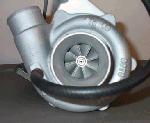
If you ask me the best thing about my car is the fact that it's turbo. I love the feeling of the turbo spooling up and the power of the engine as it's climbing in RPM's. It's a unique feeling as though your driving two different cars. One time as you get on the highway you have a normal amount of power but, if you decide that you need more you can just vary your position on the throttle and the car will take on another personallity all it's own.
The factory supplied us with an smallish T-3 turbo made Garret for Nissan. It does a fine job for those who want to well enough alone. But, why buy an old turbo car if you want to leave it as is? As most people do I played with the stock turbo until it gave out due to the compressor seals giving way and the car smoked like a frieght train. I took it to a shop and they replaced the compressor section with one off of a John Deer Tractor(basically a T4/T3). When the turbo builder told me what he had done I thought "OH NO". I guess I had that look on my face 'cause he immediatly reassured me it would work well for my application. I had to trust him and it has turned out well. This rebuild lasted for about 70,000 miles and I'm sure that other than changing the oil and using synthtics I never really did the turbo any favors. This turbo was water cooled but, I never got around to hooking up the water line.
My newest turbo is very similar to the old one only I had the turbine section upgraded to a wheel that would still help the turbo spool well but, have less backpressure going back into the head. In a turbo car the less back pressure the better. This is where a ported exhaust manifold and a nice free flowing exhaust system come into play. I have read that to really make some power in a turbo car you would want to achieve a 1 to 1 ratio of boost pressure to back pressure or even less if possible. To do this would require a turbo that would be a dog on the street so you have to make the best compromise you can and go from there. Many guys are running much bigger turbos but, until I get this one maxed out I'm not going to worry about upgrading to something bigger.
So far I've pushed this turbo past the 20 psi mark on my Autometer gauge and it worked well. I must admitt that to make anymore real power a larger turbo will be needed. A larger turbo would have a easier time providing the airflow needed to push the horsepower numbers higher. Since I drive around town with the boost set to about 15 to 16 psi this turbo will be fine for another year or two.
This is my oil line restictor. Basically what it does is prevent to much oil from entering the turbo and blowing out the seals. You still need to have enough oil flowing to the turbo but, to much can be a bad thing. What I did was to drill out the hole and tap it for a small bolt. After that I had sanded down the head of the bolt and welded up the top. Then I cleaned up the weld and drilled a small hole (.080) in the top. This should provide enough oil to the turbo at high RPM's when the oil pressure in the engine is at 65 PSI or so. At idle the turbo still needs oil but, not near what it needs when the turbo is at full song.
This is my oil line that I had made at a shop in the west side of Ft. Worth. You will need to replace the oil line anytime you replace the turbo on your car. The oil line can also get cooked up by the same heat that cooks the bearings. Mine consist of the stock ends that have end chemically and physically cleaned. They were then attatched to -4 stainless steel braided line. Not the most fancy looking piece but, it sure does the job and doesn't look bad at all.